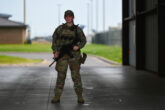January 02, 2014
A Delicate Dance: The Need to Respond to Chinese Assertiveness in the Western Pacific
Recent Chinese assertiveness, manifested in the establishment of an air defense identification zone (ADIZ) and the harassment of the USS Cowpens in the South China Sea, coupled with our allies’ growing anxiety could prove to be a dangerous mix. To date, the U.S. response has been tempered, downplaying events and urging China to re-evaluate its behavior. Behind this reticence, however, U.S. Secretary of State John Kerry announced additional maritime security assistance to Southeast Asian nations locked in a territorial dispute with China. Likewise, Japan’s new defense strategy marks a change of course, loosening the postwar ideas of pacifism and taking a more muscular stance, which includes the acquisition of new armaments. These actions are meant to check Chinese power. Although the U.S. should pursue a holistic approach towards East Asia, tying actions to promises as it continues to pivot, it must also check Chinese power in a more direct way.
The decision to fly B-52s through China’s new ADIZ lost impact when the Pentagon announced that it was a routine, planned flight. Although the action may be interpreted as a signal that the U.S. will not fully bend to the Chinese ADIZ, it also communicated an apprehensiveness to overtly challenge Chinese assertiveness. Continued failure to appropriately respond to provocative Chinese actions will reinforce the notion that these actions pay off and could lead to the perception that U.S. resolve has weakened, in turn increasing the probability that China will persist in slowly challenging the status quo. The result of this could be devastating – an accident that leads to a greater crisis, or worse yet, a war initiated by the crossing of an important U.S. redline that China believes will not be enforced. Instead, the U.S. should respond to China’s assertiveness now, initiating a course of action that demonstrates that it will neither reward nor tolerate aggressive behavior. This response must be clearly connected to a particular Chinese action and should be felt in the immediacy – not in the future. Crafting this response will require in-depth analysis and creative thinking in order to determine escalation risks and identify what China values, as well as to consider options that span the breadth of U.S. power.
This is not to suggest a tit-for-tat response or a reliance on military capabilities. Nor is it to take exception to U.S. initiatives to increase security cooperation in the region and expand our allies’ military capabilities. These initiatives have long-term payoffs that are beneficial to U.S. security. Rather it is to challenge the notion that the U.S. should not take a stronger stance against Chinese assertiveness due to a fear of escalating tensions or inappropriately using U.S. power. Failing to establish boundaries and crisis response mechanisms now will transfer risk to the future and reduce international security over the long-term.
More from CNAS
-
National Security Human Capital Program
Key Elements of the 2026 National Defense Authorization ActThis article was originally published on War on the Rocks. Although contemplating the personnel requirements of a large-scale conflict — and with it, the potential for casualt...
By Katherine L. Kuzminski
-
National Security Human Capital Program
Short SupplyExecutive Summary The U.S. military faces a critical challenge: Fewer young Americans are willing to serve, and fewer adults are encouraging them to do so. Because of delibera...
By Katherine L. Kuzminski & Taren Sylvester
-
National Security Human Capital Program
Defending the Army’s Command Assessment ProgramThe concept for CAP — developed during the first Trump administration — benefited from the guidance, input and oversight from the foremost scholar and practitioner on military...
By Katherine L. Kuzminski
-
National Security Human Capital Program
‘Women Don’t Just Achieve…They Excel’: Fmr. Marine Corps Attack PilotDr. Kyleanne Hunter, former Marine Corps attack pilot and CEO of Iraq & Afghanistan Veterans of America, says “women are the fastest growing group of veterans” and “the fastes...
By Dr. Kyleanne Hunter




